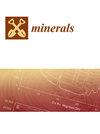脉石矿物对褐铁矿矿浆流变及浮选行为的影响
IF 2.2
4区 地球科学
Q2 GEOCHEMISTRY & GEOPHYSICS
引用次数: 2
摘要
矿浆流变性是影响浮选性能的重要因素。脉石矿物对水镁石(ZnCO3)的流变性能有重要影响。复杂的纸浆流变性(高粘度、分散性差)将对精矿的品位和回收率产生不利影响。为了解决这个问题,通过矿浆流变学测量和浮选试验,研究了脉石矿物(高岭石、方解石和石英)对史密斯岩流变性能和浮选行为的影响。结果表明,浮选回收率与矿浆流变性和高表观粘度密切相关,屈服应力导致回收率低。脉石矿物对史密斯岩流变性和产率的不利影响为高岭石>方解石>石英。粗矿物颗粒(150–74μm,74–38μm)可以降低表观粘度和屈服应力,并具有良好的可浮性,而细矿物颗粒(38–23μm,−23μm)则可以大大提高表观粘度值,并表现出较差的可漂浮性。因此,为了控制史密森铁矿的矿浆流变性,有必要在浮选前去除细粒脉石矿物(−38μm),尤其是细粒高岭石。本文章由计算机程序翻译,如有差异,请以英文原文为准。
Effect of Gangue Minerals on Pulp Rheology and Flotation Behavior of Smithsonite
The pulp rheology is an important factor affecting flotation performance. Gangue minerals have a significant impact on the rheological property of smithsonite (ZnCO3). The complex pulp rheology (high viscosity, poor dispersion) will adversely affect the grade and recovery of concentrate. To address this problem, the effect of gangue minerals (kaolinite, calcite, and quartz) on the rheological property and flotation behavior of smithsonite was investigated with the pulp rheology measurement and a flotation test. The results showed that the flotation recovery is closely associated with the pulp rheology and high apparent viscosity and that yield stress resulted in a low recovery. The detrimental influence of gangue minerals on the rheology and yield of smithsonite was kaolinite > calcite > quartz. The coarse mineral particles (150–74 μm, 74–38 μm) could reduce the apparent viscosity and yield stress and present good floatability, while fine particles (38–23 μm, −23 μm) could greatly increase the values and show poor floatability. Therefore, to control the pulp rheology of smithsonite, it is necessary to remove fine gangue minerals (−38 μm) before flotation, especially the fine kaolinite.
求助全文
通过发布文献求助,成功后即可免费获取论文全文。
去求助
来源期刊

Minerals
MINERALOGY-MINING & MINERAL PROCESSING
CiteScore
4.10
自引率
20.00%
发文量
1351
审稿时长
19.04 days
期刊介绍:
Minerals (ISSN 2075-163X) is an international open access journal that covers the broad field of mineralogy, economic mineral resources, mineral exploration, innovative mining techniques and advances in mineral processing. It publishes reviews, regular research papers and short notes. Our aim is to encourage scientists to publish their experimental and theoretical results in as much detail as possible. There is no restriction on the length of the papers. The full experimental details must be provided so that the results can be reproduced.
 求助内容:
求助内容: 应助结果提醒方式:
应助结果提醒方式:


